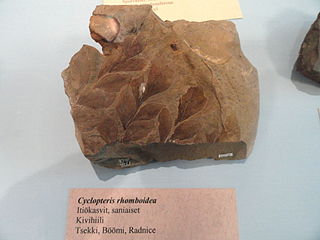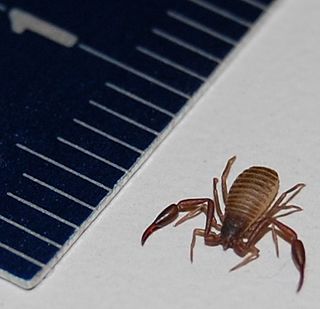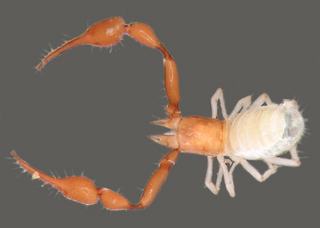Sycamore is a name which has been applied to several types of trees, but with somewhat similar leaf forms. The name derives from the ancient Greek συκόμορος (sūkomoros) meaning "fig-mulberry".

Pseudoscorpions, also known as false scorpions or book scorpions, are small, scorpion-like arachnids belonging to the order Pseudoscorpiones, also known as Pseudoscorpionida or Chelonethida.
The Sternophoridae are a family of pseudoscorpions with about 20 described species in three genera. While Afrosternophorus is an Old World genus, found mainly in Australasia, the other two genera are found in the New World, from El Salvador to the southern USA and in the Dominican Republic.
The Menthidae are a small family of pseudoscorpions that are nevertheless spread around the world. While Menthus is found from Mexico to California, Oligomenthus lives in South America. The monotypic genera Paramenthus and Thenmus live in Israel and Australia, respectively.

Chthoniidae is a family of pseudoscorpions within the superfamily Chthonioidea. The family contains more than 600 species in about 30 genera. Fossil species are known from Baltic, Dominican, and Burmese amber. Chthoniidae now includes the former families Tridenchthoniidae, and Lechytiidae which has been demoted to subfamilies.
Halgerda elegans is a species of sea slug, a dorid nudibranch, shell-less marine gastropod mollusks in the family Discodorididae.
Compsaditha is a genus of pseudoscorpions in the family Tridenchthoniidae. There are about 12 described species in Compsaditha.
Cryptoditha is a genus of pseudoscorpions in the family Tridenchthoniidae. There are at least two described species in Cryptoditha.
Ditha is a genus of pseudoscorpions in the family Tridenchthoniidae. There are about 14 described species in Ditha.

The Chernetidae are a family of pseudoscorpions with over 650 described species and 110 genera.
Olpiidae is a family of pseudoscorpions in the superfamily Garypoidea. It contains the following genera:
Horus is a genus of pseudoscorpions in the family Olpiidae, containing the following species:
Atemnidae is a family of pseudoscorpions.

Cyclopteris is an extinct genus of seed ferns in the extinct family †Cyclopteridaceae. Species are from the Carboniferous.
Synsphyronus is a genus of pseudoscorpions in the family Garypidae, which has been found in Australia, New Zealand and New Caledonia.

Garypus is a genus of pseudoscorpions in the family Garypidae. There are at least 20 described species in Garypus.

Cheliferidae is a family of pseudoscorpions in the order Pseudoscorpiones. There are at least 60 genera and 270 described species in Cheliferidae.

Syarinidae is a family of pseudoscorpions in the order Pseudoscorpiones. There are at least 20 genera and 110 described species in Syarinidae.
Austromatthaea is a genus of plants in the family Monimiaceae. As of 2010, it is considered monospecific. The sole species, Austromatthaea elegans, is found in Queensland.






